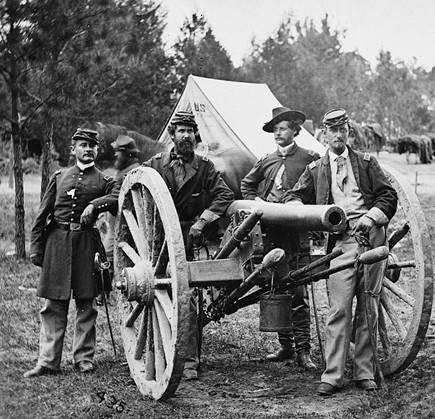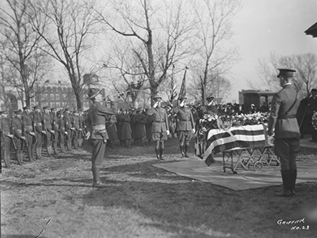Have you ever wondered how the bugle call “Taps” came to be used at memorial services for military personnel? As we prepare to celebrate Memorial Day, I thought it would be fitting to explore how this practice began.
In an earlier blog post, I presented the history of “Taps” and discussed evidence that points to the fact that the crew of USS Monitor heard “Taps” being played at some point during July or August of 1862. This post is a continuation of the history of “Taps” and how it became a part of military funerals and memorials.
John C. Tidball served as Captain of Battery A, Second U.S. Artillery during the Seven Days’ Battles, June 25 through July 1, 1862. Battery A moved to Harrison’s Landing with the rest of the Union forces after the battle of Malvern Hill.

While at Harrison’s Landing, one of the men under his command died. Captain Tidball described him as “a most excellent man.” (1) He wished to bury him with full military honors but was refused permission for the customary firing of three guns over his grave.
Captain Tidball chose to have “Taps” played instead of the three-gun salute. This was the first time “Taps” was played at a military funeral. He said, “The idea was taken up by others, until in a short time it was adopted by the entire army and is now looked upon as the most appropriate and touching part of a military funeral.” (2)
The playing of “Taps” became standard for military funerals in 1891, although I think it is safe to say that it had been played unofficially for many years prior to 1891. John Tidball died on May 15, 1906. He was the last surviving member of his West Point class of 1848. He was laid to rest with the sounding of “Taps” just as it had been played forty- four years earlier at Harrison’s Landing.
Some of you may have seen this stained-glass window in the Chapel of the Centurion at Fort Monroe. It depicts the playing of “Taps” in 1862. It is a beautiful window, but the first time I saw it I could not understand why it was there. Fort Monroe seems a long way from Harrison’s Landing. I discovered that John Tidball became Commander of the Artillery School at Fort Monroe in 1883 and served there until 1889. The Chapel had been completed in 1858, but several stained-glass windows were designed as part of the centennial celebration in 1958. The commemoration of the playing of “Taps” was one of them.
John Tidball’s daughter, Mabel Tidball, was invited to the centennial celebration in 1958. At the age 83 and living in Charleston, S.C., she was unable to attend the celebration, but requested that “Taps” be performed to remember those who had died in the past 100 years.
In 2013, the United States Congress designated “Taps” as the national “Song of Remembrance,” under Public Law 112-239, Section 596.
If you step outside and listen carefully at 3:00pm on May 31, 2021, you may hear “Taps” being played. This is a part of Taps Across America. However you celebrate Memorial Day, please take time to remember the sacrifices of so many. I leave you with this “Song of Remembrance” recorded by Jari Villanueva on the album Day is Done: 150th Anniversary of Ta
1. Eugene C. Tidball, “No Disgrace to My Country”
(The Kent State University Press, 2002, 250.
2. Tidball, 251.


